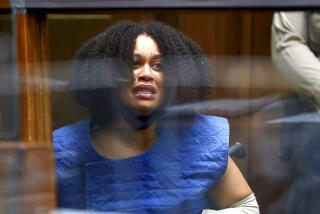Coroner’s Unit Sobered by Extent of Devastation
- Share via
As a cleansing rain washed pools of blood into the gutter along Arizona Avenue late Wednesday afternoon, half a dozen investigators from the coroner’s office hatched a plan that made as much sense as any:
Take the bodies in the same order that the 86-year-old driver ran them down. Photograph them. Place a tag on one ankle. Issue a case number. Finally, wrap the bodies in plastic sheets and roll them to one of the refrigerated vans for the Special Operations & Response Team of the Los Angeles County Coroner’s Department.
Even professionals who have cataloged death for years found Wednesday’s scene hard to comprehend.
“When we arrived, bodies were strewn all over the street,” said Erik Arbuthnot, a lead investigator. “We went methodically, one by one by one. There was a lot of work.”
At about 5 p.m., dressed in his navy blue “battle dress uniform,” forensic photographer Richard Grigalva moved down a macabre assembly line.
Click. A woman dressed “like a gypsy,” the first victim killed by the maroon Buick LaSabre that careened down Arizona. Lying on the ground near Fourth Street, she was dressed in a light purple jacket and a money belt strapped around her torso. She would later be identified as Theresa Breglia, 50.
“It looked like she had broken legs. She was looking up, like somebody tried to help her,” Grigalva said. “It’s human nature to think, ‘How can this happen?’ Once you get over that and proceed, you wonder, what was this individual thinking when they got hit?”
Next came a small girl, wearing blue jean shorts and socks, her mouth horribly bruised. Click.
“That was the hard one,” Grigalva said. “You really start thinking, what was [the driver] going through?”
Victim No. 3 wore green shorts. Tucked into the collar of his T-shirt he carried a small brown teddy bear. Leroy Lattier, 55, was a homeless man from Louisiana who had become a fixture on the local streets.
Then No. 4, a middle-aged woman lying a block west of where the devastation began.
Then No. 5, an Iranian American grandmother, run down while she was buying produce for a Sabbath dinner, her shirt pulled up and her belly exposed. Her 7-month-old grandson would later die at UCLA Medical Center in Westwood.
Then No. 6, lying on her back, a woman in khaki-colored pants and a button-down shirt, her body surrounded by cherry tomatoes and dollar bills.
Then No. 7, just inches away. She worked at the El Cholo restaurant in Santa Monica.
Finally, they came to No. 8. Click. Movsha Hoffman, 78, the last to be killed when the car finally came to stop between 2nd Street and Ocean Avenue. The man known as Michael fled Lithuania under Stalin’s rule and settled in Santa Monica.
“For one person to have done all of this,” said lead investigator Dana Bee, “it just boggles my mind. There’s no reason for any of this.”
The coroner’s special operations team was formed in 1996 to assist in incidents with five or more deaths. In 1997, it expanded to include bus, plane and train crashes, maritime accidents, major traffic collisions, mass homicides, body recoveries and fires. The team combines criminalists, investigators, technicians and attendants.
SORT has also handled high-profile cases, including the crash of an Alaska Airlines jetliner off the coast of Ventura County three years ago, which killed all 88 aboard, and last month’s plane crash into a Fairfax District apartment complex near Hollywood, which killed five people. The team was dispatched to New York after the Sept. 11 terrorist attacks.
By 7 p.m. Wednesday, investigators had retrieved eight bodies in Santa Monica and transported them to the coroner’s office at County-USC Medical Center. There, Grigalva said, the team washed and prepared the bodies for autopsies. They took hair samples, X-rays and fingerprints.
By then, the toughest part of their job was about to begin. Family members had already begun to trickle in. Others called frantically from as far away as New York. Team members began calling relatives of the dead who had been identified.
“That is far and away the worst part of this job,” Bee said.
At 2:45 p.m. Thursday, Bee made one of his last notification calls, to Louisiana. He introduced himself to Lattier’s sister, Delores, and asked her if she had been watching the news reports out of Santa Monica.
She replied, “Yes.”
“I regret to inform you that your brother was one of the victims.”
Then the sister “fell apart” and handed the phone to a neighbor, Bee said.
“It’s not the blood and gore that get to me about this job,” Bee said. “It’s having to break the hearts of families.”
Arbuthnot said he tries not to let emotions get the best of him at work. “Why be sad all day long at work?” he said. “This is what we do.”
Then he glanced at a smiling photo of his 5-year-old son, Chapin, pinned to a bulletin board and said, “but I’m glad my son was not at the farmers market yesterday.”
More to Read
Sign up for Essential California
The most important California stories and recommendations in your inbox every morning.
You may occasionally receive promotional content from the Los Angeles Times.










